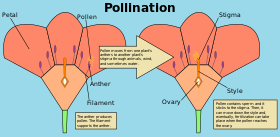**Pollination Process:**
– Pollen germination stages: hydration, activation, pollen tube emergence
– Conifers’ reproductive structures: cones, pollen cones, ovulate cones, monoecious, dioecious
– Pollen dispersal in conifers: wind, female ovulate cone structure, pollination drop
– Flowering plants’ reproduction: anthers, microspores, male gametophytes, ovules, megaspores, female gametophytes
– Pollen transfer in flowering plants: adherence to stigma, pollen tube growth, fertilization process
**Methods of Pollination:**
– Biotic vs. abiotic pollination
– Impact of natural habitat on pollination
– Biotic pollination: definition of pollinators, number of animal pollinator species, dominance of insects, diversity of pollinating animals, evolution of insect pollination
**Biotic Pollination:**
– Role of hummingbirds in pollination
– Importance of bees as pollinators
– Extent of angiosperms relying on biotic pollination
– Variety of animal pollinators
– Types of insect pollinators: bees, wasps, ants, beetles, moths, butterflies, flies
**Pollination Agents:**
– Animals as pollination agents: insects, birds, bats, water, wind, plants
– Pollination within species vs. between species
– Hybrid offspring production
– Fertilization process in angiosperms
– Fertilization process in gymnosperms
**Study of Pollination:**
– Interdisciplinary nature of pollination study
– Historical background of pollination research
– Importance of pollination in horticulture and agriculture
– Economic studies on pollination, focusing on bees
– Impact of pollination on pollinators and ecosystems
Pollination is the transfer of pollen from an anther of a plant to the stigma of a plant, later enabling fertilisation and the production of seeds. Pollinating agents can be animals such as insects, for example beetles or butterflies; birds, and bats; water; wind; and even plants themselves. Pollinating animals travel from plant to plant carrying pollen on their bodies in a vital interaction that allows the transfer of genetic material critical to the reproductive system of most flowering plants. When self-pollination occurs within a closed flower. Pollination often occurs within a species. When pollination occurs between species, it can produce hybrid offspring in nature and in plant breeding work.


In angiosperms, after the pollen grain (gametophyte) has landed on the stigma, it germinates and develops a pollen tube which grows down the style until it reaches an ovary. Its two gametes travel down the tube to where the gametophyte(s) containing the female gametes are held within the carpel. After entering an ovule through the micropyle, one male nucleus fuses with the polar bodies to produce the endosperm tissues, while the other fuses with the egg cell to produce the embryo. Hence the term: "double fertilisation". This process would result in the production of a seed, made of both nutritious tissues and embryo.
In gymnosperms, the ovule is not contained in a carpel, but exposed on the surface of a dedicated support organ, such as the scale of a cone, so that the penetration of carpel tissue is unnecessary. Details of the process vary according to the division of gymnosperms in question. Two main modes of fertilisation are found in gymnosperms: cycads and Ginkgo have motile sperm that swim directly to the egg inside the ovule, whereas conifers and gnetophytes have sperm that are unable to swim but are conveyed to the egg along a pollen tube.
The study of pollination spans many disciplines, such as botany, horticulture, entomology, and ecology. The pollination process as an interaction between flower and pollen vector was first addressed in the 18th century by Christian Konrad Sprengel. It is important in horticulture and agriculture, because fruiting is dependent on fertilisation: the result of pollination. The study of pollination by insects is known as anthecology. There are also studies in economics that look at the positives and negatives of pollination, focused on bees, and how the process affects the pollinators themselves.
